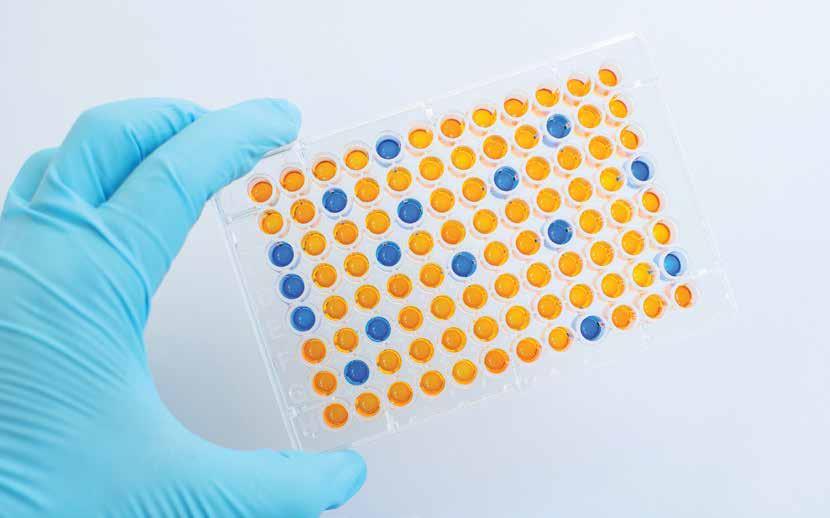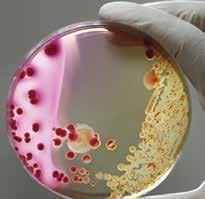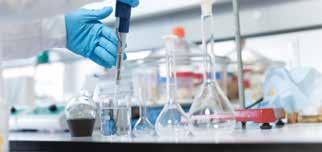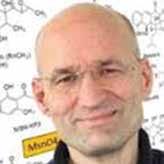Professor Andreas Bechthold – Enzyme Cofactors – Strength In Collaborations
Cofactors in enzymes are like the second key in a two key lock – absence of a cofactor renders the enzyme dysfunctional. With a collaboration map more complex than a spider’s web – the Functional Diversity of Cofactors in Enzymes Research Training group, is determined to deliver top-level science in the field.

Professor Andreas Bechthold, you are the spokesperson for the cofactor research collaborative group. How does the cofactors research training group differ from other Ph.D. programmes or research groups?
Firstly, and possibly obviously, the research focus is on cofactor dependent enzymes, and most conferences and lectures in connection with the research training group are focusing on this topic. Secondly, the group is trying to set up a bridge between the academy and the pharmaceutical and biotech industry. We hold an ‘industry lecture’ for our students, giving them the opportunity to get to know people from the industry and to discuss future job opportunities. I am very impressed by the success of this lecture so far.
The group also has an updated way of handling gender equality, offering additional services (such as workshops) to women scientists. Why do you believe gender equality in academia is important and do you think women scientists need more support to be successful?
While the principle of gender equity in the workplace is generally accepted in the west, discriminatory practices persist in many organizations. At the University, more than 50 per cent of the undergraduate students and around 50 per cent of the Ph.D. students are female in subjects such as pharmacy. However, less than 10 per cent of the professors are female. Most of the Ph.D. students are around 30 years old when they receive their Ph.D. Many Ph.D. students are planning to have a baby, and most of the time its women that take care of the baby – not getting enough time for research. Getting a permanent professor position at the University is very competitive. Many women do not even try to go for a scientific career, as they do not believe that it is possible while also raising children. We want to support women and men who are interested in science and who are also interested in starting a family.
Many of the projects of the research training group focuses on enzyme cofactors in natural products, was this a strategic approach, or is it merely mirroring the focus of the researchers composing the group?
The focus on enzyme cofactors in natural products is mirroring the interests of the researchers composing the group. When we applied for the funds to start this research collaborative group, we could count 65 joint publications about co-factors in natural products among the applying groups.
One of the outcomes of the co-factor research in natural products is the generation of novel antimicrobial substances. How is knowledge of enzyme cofactors aiding in achieving this goal?
I do not believe that the generation of novel antimicrobial substances is necessarily an expected outcome of the research collective. But there is a chance that findings will lead to novel drugs. The focus of the group is on basic science and the results might lead to future applications. For example, cofactor regeneration is an important issue in industry and some of our projects are focusing on this issue.
Describe how your protein engineering efforts merge with the focus on enzyme co-factors.
This is potentially an important issue. If you learn details about how cofactors are used by enzymes, how they bind to the enzyme and how the enzyme structure is determined by the cofactor, then protein engineering efforts will become much more effective. Conversely, protein engineering may also lead to new discoveries about enzyme cofactors and the processes in which they are involved.
What are the research training group’s research goals for the next ten years?
Our goal is that the researchers composing the research collaboration will produce even more joint publications – mirroring increased collaboration within the group. We also want to contribute to producing well-trained scientists that successfully continue their career within the industry. Last, but not least, we hope to get a second period of the RTG granted or even to become an international research training group by 2019.
INTEGRATIVE APPROACHES TO COFACTOR BASICS
While enzyme cofactors are highly interesting out of a practical perspective, Professor Bechthold and his fellow colleagues in this outstanding collaborative effort have instead set their minds on scrutinising the basic properties and functions of these factors – making up the fine threads of the web of life.

Enzymes dependent on cofactors can be found in all areas of biology – human, animal and plant alike. Cofactors contribute to survival and maintenance of organisms and, if dysfunctional, can be the root of disease. However, these molecules – both organic and inorganic – transcend biology and are increasingly finding applications in other fields. But for such applications to become reality, someone first has to lay the foundations, providing detailed knowledge about which these factors are, and how they look and function.
Interdisciplinary focus
As academics know, and non-academics suspect, scientists within academia tend to be extremely specialized within their field, and knowledge of current research advances within neighbouring disciplines tend to slip by unnoticed. This is in part a prerequisite allowing the total focus on a subject that may lead to new discoveries. Biology is, however, not divided into faculties, and academic institutions increasingly realize the importance of collaborating across traditional departmental boundaries to produce state of the art research.
The Functional Diversity of Cofactors in Enzymes Research Training Group has taken scientific collaborations to a new level, forming a truly multidisciplinary team with contributing researchers from the Faculties of Chemistry, Pharmacy, Biology and Medicine and extensive partnerships outside academia. Using this approach, they hope to contribute to making the Institute of Pharmaceutical Sciences in Freiburg one of the top pharmaceutical institutes in Europe.
The ‘training’ part of the long name the group have chosen, witnesses of a part of academic life often overlooked by senior scientists. Traditionally, Ph.D. candidates within academia are trained to perform well within an academic context. A Ph.D. is, however, a gold mine in terms of transferable soft skills.
Unlike many academical institutions, the enzyme cofactor research-training group has a clear focus on producing excellent scientists that are capable of launching their independent careers – within academia and beyond – once graduated.
Young scientists also have all the support they can imagine in terms of providing equal opportunities for both women and men. Researchers with young children are offered flexible work conditions and the University even have its own child care facilities – all to allow young researchers to continue doing what they do best.
“The most successful time of a researcher is when the scientist is young. Most young scientists are flexible enough to overcome conservative structures, and they are much better in creating novelty”, says Professor Bechthold when explaining the generous support structures. As someone who successfully coached 38 Ph.D. candidates through their studies, he should know what he is talking about.

Enzymes for drug discovery
A large part of the projects within the collaborative group focuses on cofactors in enzymes related to natural substances. While drug discovery is not a specified goal of the research collective, work performed in the various labs sometimes lead to discoveries with a translational potential.
Mathematical models have predicted that streptomycetes – actinobacteria studied by several labs within the research collective – can produce approximately 100,000 antibiotics. Only about three per cent of them have been discovered so far.
By developing new techniques for culturing previously uncultivable bacterial species as well as using genomic sequencing, genome mining, high throughput miniaturized screening and combinatorial biosynthesis, the chances of identifying substances with antimicrobial properties radically increase. While big pharmaceutical companies have lost their interest in the field, focusing on drugs with a bigger potential for economic gain, small biotech companies have plunged into the field.
Andreas Bechthold was not late to realize the potential of the serendipitously discovered substances. Together with eight colleagues, he started Combinature Biopharm, a small biotech that after merging with MerLion Pharmaceuticals successfully brought finafloxacin – an antibiotic for the treatment of otitis – to the market. The drug is also in clinical trials for a large number of other indications, including infections in patients with chronic obstructive pulmonary disease and cystic fibrosis, as well as hospital acquired infections such as MRSA.

A deeper understanding of the works
While drug development of substances discovered by the researchtraining group is a fortunate by product of their work, most of the efforts within the collective focus on basic research questions. A more thorough understanding of cofactors; their synthetic paths, their structures as well as mechanics and enzymology of the corresponding enzyme interactions, are a prerequisite for more applied research by researchers in neighbouring fields.
Professor Bechthold leads a project exploring cofactor-dependent luciferase–like proteins involved in the synthesis of natural products with antibiotic and cytostatic effects. The knowledge of these enzymes allows for the manipulation of their characteristics. In the field of protein engineering, such knowledge can lead to the production of drugs with better properties, such as increased stability. In an innovative approach, Professor Bechthold uncovered what it takes to change an enzyme producing O-glycosidic bonds, to one that binds carbon by glycosylation instead. C-glycosylated proteins are valuable in drug discovery, because they mimic the features of the O-glycosylated factors, but are far more stabile. By introducing such a genetically engineered enzyme into a biosynthetic pathway, substances with more desirable characteristics can be produced in a process called combinatorial biosynthesis. Professor Bechthold also studies the enzymes leading to the biosynthesis of mensacarcin and rishirilid. Mensacarin is an experimental drug with potent antitumor activity. It is, however, far too toxic to be used in humans. Knowledge of the biosynthetic pathways could nevertheless aid in producing compounds with more desirable characteristics. Another group, led by Dr. Susana Andrade, is working on characterizing flavoproteins – in atomic detail – as she likes to put it. These proteins have the organic cofactor flavin adenine dinucleotide in common. Working together with Drs. Jung and Boll, Dr. Andrade is also investigating the medicinal and ecological potential of these FADdependent proteins.
Dr. Oliver Einsle´s group (nitogenase) and Dr. Friedrich´s group (NADH:ubiquinone oxidoreductase) are both working on cofactors of enzymes which are essential for life.
Dr. Boll’s group, in turn, focuses on enzymatic ring reduction under anaerobic conditions –processes that are present in a large variety of cofactors. Yet others, such as Drs. Weber and Schleicher concentrate on the identification and characterization of paramagnetic cofactors in proteins by using continuous–wave and time–resolved magnetic resonance techniques, as well as transient absorption spectroscopy. Such paramagnetic species are involved in both light, and dark activated enzymes.
Cofactor mimicry
Co-factors have traditionally not been the main focus of drug development efforts. Drs. Günther and Jung, however, argue that the identification of cofactor mimicking inhibitors could provide a range of hitherto unexplored pharmaceutical targets. Such a search does not necessarily require laboratory work. Instead, they can predict biological effects of molecules using cheminformatics methods, such as structure-based prediction of molecular interactions and in silico screening techniques. Through the extensive collaborative network, the properties of molecules theoretically identified to have a biological activity can then be immediately validated in biological assays developed by Dr. Jung and others. “We believe that drug development will benefit from more knowledge about cofactors,” says Professor Bechthold.
A biotechnological connection
When speaking of enzyme co-factors, people mostly think of biology and medicine. Enzymes, however, transcend the boundary between biology and technology, and the production of tailored enzymes for use in various technological applications is a promising field. Enzymes can, for example, be used in chemical synthesis, providing benefits such as milder reaction conditions compared to traditional methods.
Methyltransferase enzymes catalysing alkyl transfer have many potential technological applications. These enzymes use S– adenosylmethionine (SAM) as the crucial cofactor – transferring a methyl group to a target compound. In living cells, SAM is recycled in a complex, multistep process. By closely investigating these steps, Dr. Axender hopes to produce a toolbox to be used with methyltransferase catalysed alkyl transfer – offering biological solutions to technical problems.
The group, led by Dr. Michael Müller, is investigating a class of enzymes, known to catalyse oxidative phenol coupling. The focus is on understanding and hopefully to then use these enzymes in biotechnological approaches.
The research of the collaborative group continuously acts on levels close to practical applications, allowing other researchers to pick the ball up for translational applications. By joining forces, the combined knowledge and technical expertise of the research collaborative group lift the research to a level unprecedented in the field.
Meet the researcher

Professor Andreas Bechthold
Institute of Pharmaceutical Sciences, Pharmaceutical Biology and Biotechnology
Albert-Ludwigs-Universität Freiburg, Germany
Since graduating in pharmacy studies almost thirty years ago, Professor Andreas Bechthold has now an impressive list of engagements. He is a Professor of Pharmaceutical Biology and Biotechnology at the University of Freiburg, as well as the Dean of Study and member of the managing committee of the Faculty for Chemistry and Pharmacy at the University. He is also a member of both the German-French Ph.D. College ‘Membrane Proteins and Biological Membranes’, and the ‘Spemann Graduate School of Biology and Medicine’ at the University of Freiburg. Moreover, he is the spokesperson for the Cofactor Research Training Group and a co-founder of Combinature Biopharm AG.
CONTACT
T: +49 761 203 8371
E: andreas.bechthold@pharmazie.uni-freiburg.de
W: https://www.pharmbio.uni-freiburg.de/foldrgbechth
W: https://www.cofactor-diversity.uni-freiburg.de/FOR1296
KEY COLLABORATORS
Dr. David Zechel, Queens University
Dr. Andriy Luzhetskyy, Universität des Saarlandes
Dr. Thomas Paululat, Universität Siegen
Dr. Jose Salas, Universidad de Oviedo
Dr. Jürgen Rohr, University of Kentucky
Dr. Heinz Floss, Seattle University
Prof. Susana Andrade, Universität Freiburg
Prof. Oliver Einsle, Universität Freiburg
Prof. Thorsten Friedrich, Universität Freiburg
Dr. Stefan Günther, Universität Freiburg
Prof. Michael Müller, Universität Freiburg
FUNDING
DFG
EC
BMBF
DAAD
BW
REFERENCES
Gessner, A., Heitzler, T., Zhang, S., Klaus, C., Murill, R., Zhao, H., Vanner, S., Zechel, D., Bechthold, A. (2015) Changing biosynthetic profiles by expressing bldA in Streptomyces strains. ChemBioChem 16(15): 2244- 2252.
Tam, H.K., Härle, J., Gerhardt, S., Rohr,J., Thorson, J.S., Bigot,A., Lutterbeck, M., Seiche, W., Breit, B., Bechthold, A., Einsle, O. (2015) Structural Characterization of O- and C-glycosylating variants of the landomycin glycosyltransferase LanGT2. Angewandte 54(9): 2811-2815
Maier, S., Pflüger, T., Loesgen, S., Asmus, K., Brötz, E., Paululat, T., Zeeck, A., Bechthold, A. (2014) Novel insights into the bioactivity and epoxide formation in mensacarcin by MsnO8. ChemBioChem 15(5):749-56 Strobel, T., Schmidt, Y., Linnenbrink, A., Luzhetskyy, A., Luzhetska, M., Taguchi, T., Brötz, E., Paululat, T., Stasevych, M., Stanko,, O., Novikov, V., Bechthold, A. (2013) Tracking down biotransformation to the genetic level: Identfication of a highly flexible glycosyltransferase from Saccharothrix espanaensis. AEM 79(17): 5224-5232
Kalan, L., Gessner, A., Szawiola, A., Thaker, A., Bechthold, A., Wright, G., Zechel, D. (2013) A cryptic polyene biosynthetic gene cluster in Streptomyces calvus is expressed upon complementation with a functional bldA gene. ChemBiol 20: 1214-1224
Yan, X., Probst, K., Linnenbrink, A., Arnold, M., Paulutat, T., Zeeck, A., Bechthold, A. (2012) Cloning and heterologous expression of three type II PKS gene clusters from Streptomyces bottropensis. ChemBioChem 13(2): 224-230.
Härle, J., Günther, S., Lauinger, B., Weber, M., Kammerer, B., Zechel, D.L., Luzhetskyy, A., Bechthold, A. (2011) Rational design of an aryl- C-glycoside catalyst from a natural product O-glycosyltransferase. ChemBiol., 18(4): 520-53



